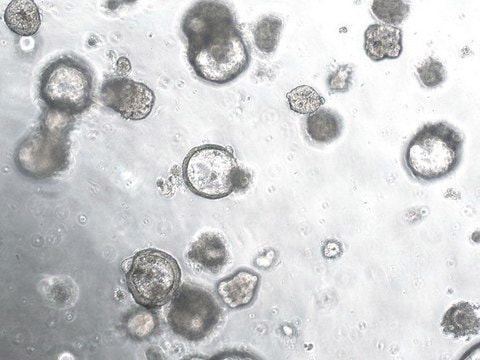SCM162
DMEM/F-12 PLUS Basal Medium
Advanced DMEMF12 basal media used in low-serum or serum-free media formulations including stem cell and 3D organoid cell cultures.
Synonym(s):
Advanced DMEM/F12, Organoid Basal Media, Organoid Basal Media, DMEMF12, DMEM F12, Dulbecco′s Modified Eagle Medium/Ham′s F-12, Serum-Free Basal Media
About This Item
Recommended Products
form
liquid
technique(s)
cell culture | stem cell: suitable
General description
• Culture of primary, stem cells and cell lines in applications that require reduced or serum-free medium.
• Optimization of transfections that require reduced or serum-free conditions.
• Production of conditioned medium in reduced serum or serum-free conditions.
• Optimized media for the culture and expansion of multiple 3D organoids and tissues systems.
DMEM/F12 PLUS is a proprietary formulation that contains human serum albumin (HSA), defined lipids, trace elements, chemicals and proteins essential for optimal cell growth in reduced serum conditions. The media contains high-glucose and does not contain L-glutamine or penicillin-streptomycin.
Application
Stem Cell Research
Quality
Osmolality: 290-330 mOsm
pH: 7.2-7.4
Sterility Tested: No Growth/Pass
Endotoxin: <2 EU/mL
Mycoplasma: Negative
Storage and Stability
Disclaimer
Storage Class Code
12 - Non Combustible Liquids
WGK
WGK 1
Flash Point(F)
Not applicable
Flash Point(C)
Not applicable
Certificates of Analysis (COA)
Search for Certificates of Analysis (COA) by entering the products Lot/Batch Number. Lot and Batch Numbers can be found on a product’s label following the words ‘Lot’ or ‘Batch’.
Already Own This Product?
Find documentation for the products that you have recently purchased in the Document Library.
Customers Also Viewed
Articles
Human pancreatic cancer organoid biobank (PDAC organoids) with various KRAS mutations to aide in 3D cell culture and cancer research applications.
Human pancreatic cancer organoid biobank (PDAC organoids) with various KRAS mutations to aide in 3D cell culture and cancer research applications.
Human pancreatic cancer organoid biobank (PDAC organoids) with various KRAS mutations to aide in 3D cell culture and cancer research applications.
Human pancreatic cancer organoid biobank (PDAC organoids) with various KRAS mutations to aide in 3D cell culture and cancer research applications.
Protocols
How to stain organoids? A complete step-by-step protocol for immunofluorescent (IF) and immunocytochemical (ICC) staining of organoid cultures using antibodies
A rapid in vitro assay for CFTR function, the forskolin-induced swelling protocol uses human colon organoids, which can be derived from cystic fibrosis patient tissue.
Related Content
Monitor barrier formation using colon PDOs, iPSC-derived colon organoids, Millicell® cell culture inserts, and the Millicell® ERS. 3.0.
Monitor barrier formation using colon PDOs, iPSC-derived colon organoids, Millicell® cell culture inserts, and the Millicell® ERS. 3.0.
Monitor barrier formation using colon PDOs, iPSC-derived colon organoids, Millicell® cell culture inserts, and the Millicell® ERS. 3.0.
Our team of scientists has experience in all areas of research including Life Science, Material Science, Chemical Synthesis, Chromatography, Analytical and many others.
Contact Technical Service








